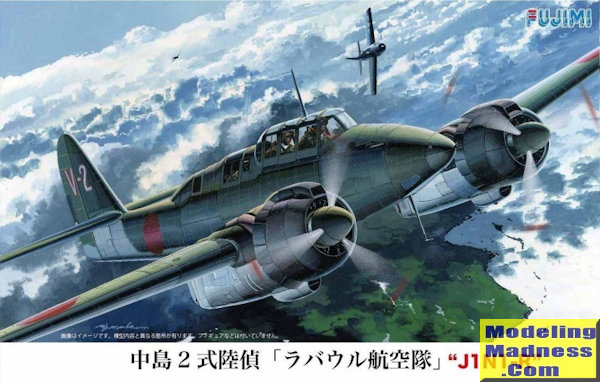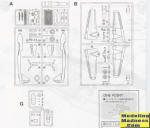
Fujimi 1/72 J1N1-R 'Gekko'
| KIT #: | 722719 |
| PRICE: | 1620 yen plus 1/3 of shipping (533 yen) = 2153 yen (a bit over $19.00) |
| DECALS: | Five options |
| REVIEWER: | Scott Van Aken |
| NOTES: |
2015 boxing |

| HISTORY |
In mid-1938 the Japanese Imperial Navy requested a twin-engine fighter designed to escort the principal bomber used at the time, Mitsubishi G3M "Nell". The operating range of the standard Navy fighter, the Mitsubishi A5M "Claude", was only 1,200 km (750 mi), insufficient compared with the 4,400 km (2,730 mi) of the G3M. Moreover, at the time, the potential of the "Zero", then still under development, remained to be evaluated, stressing the need for a long-range escort fighter, much as the Luftwaffe had done with the Messerschmitt Bf 110 Zerstörer, introduced the year before.
In March 1939, Mitsubishi and Nakajima began the development of a project 13-Shi. The prototype left the factory in March 1941 equipped with two 843 kW (1,130 hp) Nakajima Sakae 21/22, 14-cylinder radial engines. There was a crew of three, and the aircraft was armed with a 20 mm Type 99 cannon and six 7.7 mm (.303 in) Type 97 aircraft machine guns. Four of these machine guns were mounted in two rear-mounted powered turrets, the weight of which reduced the performance of the aircraft considerably. Because of the sluggish handling, being used as ae escort fighter had to be abandoned. Instead, production was authorized for a lighter reconnaissance variant, the J1N1-C, also known by the Navy designation Navy Type 2 Reconnaissance Plane. One early variant, the J1N1-F, had a spherical turret with one 20 mm Type 99 Model 1 cannon mounted immediately behind the pilot.
In early 1943, Commander Yasuna Kozono(小園 安名 of the 251st Kōkūtai in Rabaul came up with the idea of installing 20 mm cannons, firing upwards at a 30-degree angle in the fuselage. Against orders of central command, which was skeptical of his idea, he tested his idea on a J1N1-C as a night fighter. The field-modified J1N1-C KAI shot down two B-17s of 43rd Bomb Group attacking air bases around Rabaul on 21 May 1943.
The Navy took immediate notice and placed orders with Nakajima for the newly designated J1N1-S night fighter design. This model was christened the Model 11 Gekko (月光, "Moonlight"). It had a crew of two, eliminating the navigator position. Like the KAI, it had twin 20 mm Type 99 Model 1 cannon firing upward in a 30° upward angle, but added a second pair firing downward at a forward 30° angle, allowing attacks from above or below. This arrangement was effective against B-17 Flying Fortress bombers and B-24 Liberators, which usually had Sperry ball turrets for ventral defense. The Gekko's existence was not quickly understood by the Allies, who assumed the Japanese did not have the technology for night fighter designs. Early versions had nose searchlights in place of radar. Later models, the J1N1-Sa Model 11a, omitted the two downward-firing guns and added another 20 mm cannon to face upward as with the other two. Other variants without nose antennae or searchlight added a 20 mm cannon to the nose.
The J1N1-S was used against B-29 Superfortresses in Japan, though the lack of good radar and insufficient high-altitude performance handicapped it, since usually only one pass could be made against the higher-speed B-29s. However, some skillful pilots had spectacular successes, such as Lieutenant Sachio Endo, who was credited with destroying eight B-29s and damaging another eight before he was shot down by a B-29 crew, Shigetoshi Kudo (nine victories), Shiro Kuratori (six victories), and Juzo Kuramoto (eight victories); the last two claimed five B-29s during the night of 25–26 May 1945. Another Gekko crew shot down five B-29's in one night, but these successes were rare. Many Gekkos were also shot down or destroyed on the ground. A number of Gekkos were relegated to kamikaze attacks, using 250 kg (550 lb) bombs attached to the wings.
| THE KIT |

I am going to suppose that the various boxings of this kit include the same plastic as there are parts shown on the sprue that are not used. I also had difficulty finding any information on the -R version, but what little I did find stated that the aircraft had but two guns; one 20mm and one rear facing, hand held 7.7mm gun.
The cockpit is quite basic consisting of two seats, a control stick and an instrument panel that fit onto a floor section. Decals are used for instruments. Equally basic are the engines with a forward engine face fitting into a single-piece cowling. The props have the forward part of the spinner molded in place.
Now for the aircraft options. The first two are shown as having the full turrets in the upper fuselage. These are covered by transparencies, which I find a tad odd so apparently these somehow moved out of the way prior to firing. The kit includes five short sections of metal used to replace the gun barrels. This set-up is used for the first two markings options. The other three have the upward and downward firing 20mm cannon. Again, the metal sections are used to replace the plastic barrels. There are detail instructions on the length these are to be cut for each option.
For things under wings, one can install a pair of fuel tanks. For these tanks and the angled cannon, holes need to be opened. The wings have a single lower wing with a clear window section and two upper wing sections. There is no wheel well detail, just two large attachment points for the landing gear legs. There are single piece main gear doors to attach with the tail doors already molded in the open position. Note that the tail gear needs to be installed when the fuselage halves are put together.
 Instructions
are well done and provide the usual Gunze paint options. The upper surface
green, the cowlings and the prop colors need to be mixed. The underside color is
H-61, but this shade is not shown on the paint reference chart. I assume it is
light grey. The box art plane is from the Tainan Kokutai from October 1942 with
the next option being with the 151st Kokutai in May 1943. The next three are all
night fighters with all three being from the 251st Kokutai on Rabaul in May/June
1943. The decal sheet is nicely done and provides a bunch of additional numbers
so you can do other planes aside from what is on the decal sheet.
Instructions
are well done and provide the usual Gunze paint options. The upper surface
green, the cowlings and the prop colors need to be mixed. The underside color is
H-61, but this shade is not shown on the paint reference chart. I assume it is
light grey. The box art plane is from the Tainan Kokutai from October 1942 with
the next option being with the 151st Kokutai in May 1943. The next three are all
night fighters with all three being from the 251st Kokutai on Rabaul in May/June
1943. The decal sheet is nicely done and provides a bunch of additional numbers
so you can do other planes aside from what is on the decal sheet.
| CONCLUSIONS |
Many years ago, I bought a kit that included three of these planes in a boxed set. I've yet to build any of those three and wanted to keep the set intact. Now I don't have to worry about that and have a single boxing that I can build. Those who have built Fujimi kits from this time period are aware that sometimes they can display fit issues, so it will be interesting to see if this is one of those. One thing for sure, aside from the ancient, but still nice Revell kit, this is probably your best bet in this scale.
| REFERENCES |
https://en.wikipedia.org/wiki/Nakajima_J1N
April 2016 Copyright ModelingMadness.com Thanks to me for picking this one up. If you would like your product reviewed fairly and fairly quickly, please contact the editor or see other details in the
Note to
Contributors.